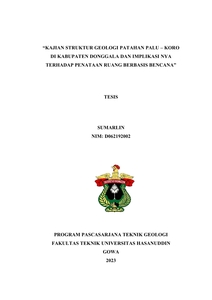Sumarlin, Sumarlin (2023) Kajian Struktur Geologi Patahan Palu – Koro di Kabupaten Donggala dan Implikasi nya Terhadap Penataan Ruang Berbasis Bencana = Study of the Geological Structure of the Palu – Koro Fault in Donggala Regency and Implications for Disaster-Based Spatial Planning. Thesis thesis, Universitas Hasanuddin.
![[thumbnail of Cover]](/32633/1.hassmallThumbnailVersion/D062192002_tesis_16-11-2023%20CAVER1.jpg)

D062192002_tesis_16-11-2023 CAVER1.jpg
Download (221kB) | Preview
D062192002_tesis_16-11-2023 BAB 1-2.pdf
Download (2MB)
D062192002_tesis_16-11-2023 DP.pdf
Download (87kB)
D062192002_tesis_16-11-2023.pdf
Restricted to Repository staff only until 1 January 2026.
Download (9MB)
Abstract (Abstrak)
The Donggala Regency area is known for high seismic intensity, due to this area being cross-cut by a major strike-slip fault namely the Palu-Koro Fault. While it is understood that the growth of population and infrastructure is increasing in this region, it becomes a crucial consideration or variable in regional spatial planning. Spatially, the fault zone is divided into three components namely fault core, damage zone, and wall rocks. which has a product and influence on fracture intensity, seismicity, and the level of slope stability in an area. Therefore, this study aims to analyze the geological structural components in each fault zone as a basis for considering the planning and suitability of regional spatial planning and disaster mitigation in the area. This research method is divided into secondary data collection (Peak Ground Acceleration (PGA), growth population level, and infrastructure utilities), field surveys including the data collection of components and dimensions of geological structures (fractures/joints), slope intensity, and safety factor analysis to determine the appropriateness of the regional spatial planning with the fault zone. The analysis results from three measurement sites suggest that the fault core zone shows high intensity (6.1 – 13.1%) with a safety factor between 1.57 – 76.2, which is in the moderate population. Four sites in the damage zone show high intensity (3.54 – 9.4%), with a safety factor between 2.8 – 12.6, belonging to the moderate population. Three sites in the wall rocks zone show high intensity (11 – 13.1%), with a safety factor between 1.4 – 58.4, belonging to a moderate population. Based on the results of the analysis above, it can be concluded that based on the fracture intensity and slope safety factor are generally high, so the Palu – Koro fault zone is not in accordance with the Donggala area spatial planning. The implication of this research suggests that regional spatial planning must consider fault zone (fault core, damage zone, and wall rock).
Keywords : geological structure, fault zone, joints, Donggala, Palu – Koro
| Item Type: | Thesis (Thesis) |
|---|---|
| Uncontrolled Keywords: | geological structure, fault zone, joints, Donggala, Palu – Koro |
| Subjects: | T Technology > TA Engineering (General). Civil engineering (General) |
| Divisions (Program Studi): | Fakultas Teknik > Teknik Geologi |
| Depositing User: | S.Sos Rasman - |
| Date Deposited: | 25 Apr 2024 02:11 |
| Last Modified: | 25 Apr 2024 02:11 |
| URI: | http://repository.unhas.ac.id:443/id/eprint/32633 |


